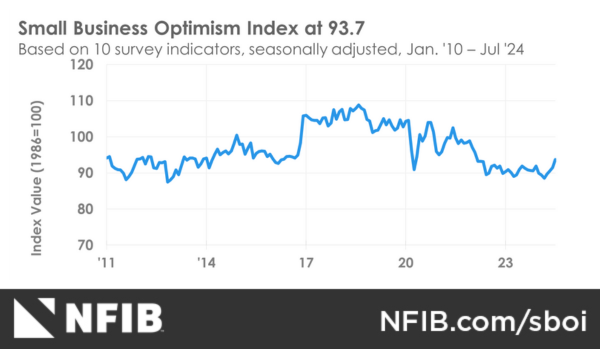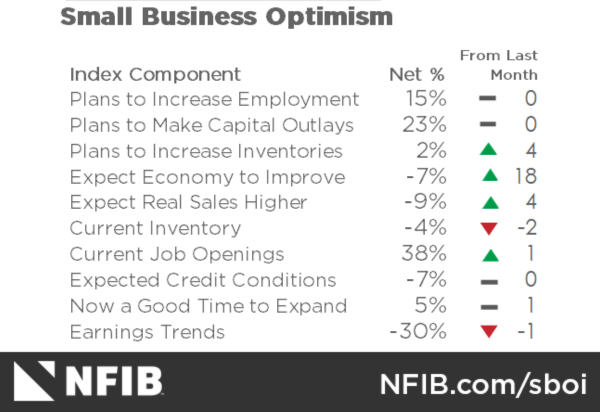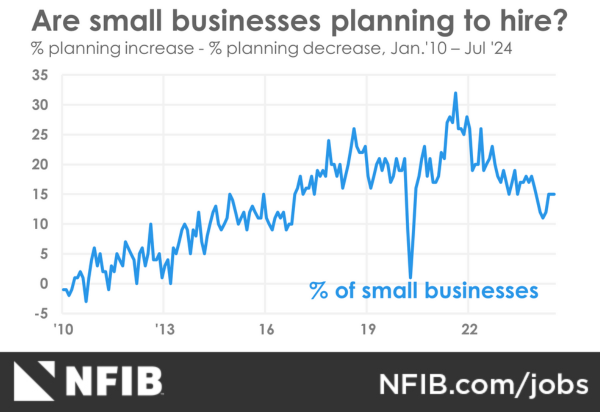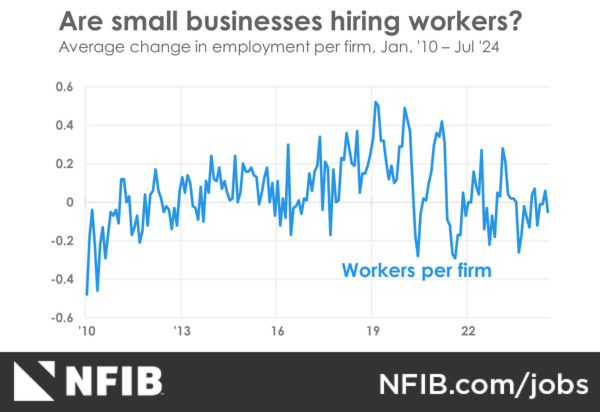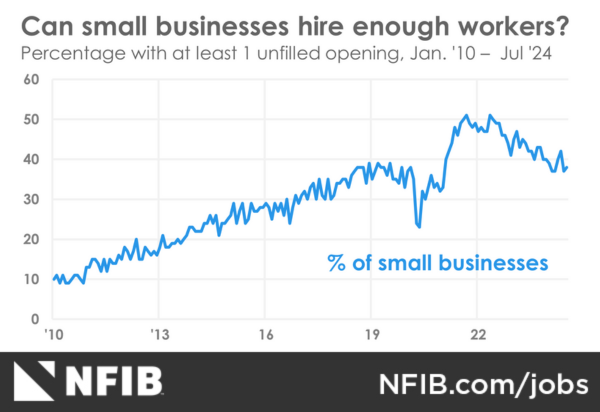The NFIB Research Foundation has collected Small Business Economic Trends data with quarterly surveys since the 4th quarter of 1973 and monthly surveys since 1986. Survey respondents are drawn from NFIB’s membership. The report is released on the second Tuesday of each month. This survey was conducted in July 2024.
Small Business Optimism Index
July 2024 Report:
Inflation Continues to Plague Main Street
The NFIB Small Business Optimism Index rose 2.2 points in July to 93.7, the highest reading since February 2022. However, this is the 31st consecutive month below the 50-year average of 98. Inflation remains the top issue among small business owners, with 25% reporting it as their single most important problem in operating their business, up four points from June.
“Despite this increase in optimism, the road ahead remains tough for the nation’s small business owners,” said NFIB Chief Economist Bill Dunkelberg. “Cost pressures, especially labor costs, continue to plague small business operations, impacting their bottom line. Owners are heading towards unpredictable months ahead, not knowing how future economic conditions or government policies will impact them.”
Key findings include:
- Seasonally adjusted, a net 33% reported raising compensation in July, down five points from June and the lowest reading since April 2021.
- A net 2% (seasonally adjusted) of owners plan inventory investment in the coming months, up four points from June. The last time inventory investment plans were positive was in October 2022.
- The net percent of owners expecting higher real sales volumes rose four points in July to a net negative 9% (seasonally adjusted), the highest reading of this year.
- The net percent of owners raising average selling prices fell five points from June to a seasonally adjusted net 22%.
- Seasonally adjusted, a net 24% plan price hikes in July (down two points). This is the lowest reading since April 2023.
- Thirty-eight percent (seasonally adjusted) of all owners reported job openings they could not fill in the current period, up one point from June.
As reported in NFIB’s monthly jobs report, a seasonally adjusted 38% of all small business owners reported job openings they could not fill in their current period, up one point from June. Of the 57% of owners hiring or trying to hire in July, 86% reported few or no qualified applicants for the positions they were trying to fill.
Fifty-four percent of owners reported capital outlays in the last six months, up two points from June. Of those making expenditures, 36% reported spending on new equipment, 22% acquired vehicles, and 15% improved or expanded facilities. Ten percent spent money on new fixtures and furniture and 7% acquired new buildings or land for expansion. Twenty-three percent (seasonally adjusted) plan capital outlays in the next six months, unchanged for the third consecutive month.
A net negative 16% of all owners (seasonally adjusted) reported higher nominal sales in the past three months. The net percent of owners expecting higher real sales volumes rose four points to a net negative 9% (seasonally adjusted), the highest reading of this year.
The net percent of owners reporting inventory gains fell six points to a net negative 9%, the lowest since August 2020. Not seasonally adjusted, 11% reported increases in stocks and 17% reported reductions.
A net negative 4% (seasonally adjusted) of owners viewed current inventory stocks as “too low” in July, down two points from June. A net 2% (seasonally adjusted) of owners plan inventory investment in the coming months, up four points from June. The last time this was positive was in October 2022.
The net percent of owners raising average selling prices fell five points from June to a net 22% seasonally adjusted. Twenty-five percent of owners reported that inflation was their single most important problem in operating their business. Unadjusted, 13% reported lower average selling prices and 36% reported higher average prices.
Price hikes were the most frequent in the finance (57% higher, 6% lower), wholesale (47% higher, 9% lower), retail (40% higher, 14% lower), and construction (38% higher, 7% lower) sectors. Seasonally adjusted, a net 24% plan price hikes in July. This is the lowest reading since April 2023.
Seasonally adjusted, a net 33% reported raising compensation, down five points from June and the lowest reading since April 2021. A seasonally adjusted net 18% plan to raise compensation in the next three months, down four points from June. Nine percent of owners cited labor costs as their top business problem, down two points from June and only four points below the highest reading of 13% reached in December 2021. Nineteen percent said that labor quality was their top business problem, remaining behind inflation as the number one issue.
The frequency of reports of positive profit trends was a net negative 30% (seasonally adjusted), one point worse than June. Among owners reporting lower profits, 33% blamed weaker sales, 17% blamed the rise in the cost of materials, 11% cited labor costs, and 10% cited lower selling prices. For owners reporting higher profits, 45% credited sales volumes, 31% cited usual seasonal change, and 11% cited higher selling prices.
Two percent of owners reported that all their borrowing needs were not satisfied. Twenty-five percent reported all credit needs met and 62% said they were not interested in a loan. A net 6% reported their last loan was harder to get than in previous attempts.
Three percent of owners reported that financing was their top business problem in July, down one point from June.
The NFIB Research Center has collected Small Business Economic Trends data with quarterly surveys since the fourth quarter of 1973 and monthly surveys since 1986. Survey respondents are randomly drawn from NFIB’s membership. The report is released on the second Tuesday of each month. This survey was conducted in July 2024.
LABOR MARKETS
Thirty-eight percent (seasonally adjusted) of all owners reported job openings they could not fill in the current period, up 1 point from June. Thirty-two percent have openings for skilled workers (up 1 point) and 16 percent have openings for unskilled labor (unchanged). The difficulty in filling open positions is particularly acute in the construction, transportation, and retail sectors. Job openings in construction were up 4 points from last month and over half of the firms (55 percent) have a job opening they can’t fill. Openings were the lowest in the agriculture and finance sectors. A seasonally adjusted net 15 percent of owners plan to create new jobs in the next three months, unchanged for the third consecutive month. Overall, 57 percent reported hiring or trying to hire in July, down 3 points from June. Forty nine percent (86 percent of those hiring or trying to hire) of owners reported few or no qualified applicants for the positions they were trying to fill (down 2 points). Twenty-nine percent of owners reported few qualified applicants for their open positions (down 2 points) and 20 percent reported none (unchanged). Reports of labor quality as the single most important problem for business owners were unchanged from the previous month at 19 percent. Labor cost reported as the single most important problem for business owners fell 2 points to 9 percent, 4 points below the highest reading of 13 percent reached in December 2021.
CAPITAL SPENDING
Fifty-four percent reported capital outlays in the last six months, up 2 points from June. A recovery in investment is needed to support stronger productivity, but this is unlikely to occur while interest rates remain high, and many owners anticipate slower sales. Long term, the worker shortage has given firms an incentive to invest in labor saving technology. But, overall, capital spending is sluggish and not yet back to pre-pandemic levels. Of those making expenditures, 36 percent reported spending on new equipment (up 1 point), 22 percent acquired vehicles (unchanged), and 15 percent improved or expanded facilities (up 1 point). Ten percent spent money on new fixtures and furniture (unchanged) and 7 percent acquired new buildings or land for expansion (up 2 points). Twenty-three percent (seasonally adjusted) plan capital outlays in the next six months, unchanged for the third consecutive month. A more positive view of the future economy and economic policy would help stimulate longer term investment spending, but currently owners’ views about the future are not supportive and financing costs are very high. Investment is needed to address labor supply chain problems which still persist in the current environment.
INFLATION
The net percent of owners raising average selling prices fell 5 points from June to a net 22 percent seasonally adjusted. Twenty-five percent of owners reported that inflation was their single most important problem in operating their business (higher input and labor costs), up 4 points from June. Unadjusted, 13 percent (up 1 point) reported lower average selling prices and 36 percent (down 5 points) reported higher average prices. Price hikes were most frequent in the finance (57 percent higher, 6 percent lower), wholesale (47 percent higher, 9 percent lower), retail (40 percent higher, 14 percent lower), and construction (38 percent higher, 7 percent lower) sectors. Seasonally adjusted, a net 24 percent plan price hikes in July (down 2 points). This is the lowest reading since April 2023.
CREDIT MARKETS
Two percent of owners reported that all their borrowing needs were not satisfied, down 2 points from June. Twenty-five percent reported all credit needs met (up 1 point) and 62 percent said they were not interested in a loan (up 1 point). A net 6 percent reported their last loan was harder to get than in previous attempts (down 1 point). Three percent reported that financing was their top business problem in July (down 1 point). A net 15 percent of owners reported paying a higher rate on their most recent loan, unchanged from June and the lowest reading since May 2022. The average rate paid on short maturity loans was 9.4 percent, down 0.1 of a point from last month. Twenty-seven percent of all owners reported borrowing on a regular basis, down 1 point from June.
COMPENSATION AND EARNINGS
Seasonally adjusted, a net 33 percent reported raising compensation, down 5 points from June and the lowest reading since April 2021. A seasonally adjusted net 18 percent plan to raise compensation in the next three months, down 4 points from June. Nineteen percent said that labor quality was their top business problem (unchanged), remaining behind inflation as the number one issue. The frequency of reports of positive profit trends was a net negative 30 percent (seasonally adjusted), 1 point worse than June. Among owners reporting lower profits, 33 percent blamed weaker sales, 17 percent blamed the rise in the cost of materials, 11 percent cited labor costs, and 10 percent cited lower selling prices. For owners reporting higher profits, 45 percent credited sales volumes, 31 percent cited usual seasonal change, and 11 percent cited higher selling prices.
SALES AND INVENTORIES
A net negative 16 percent of all owners (seasonally adjusted) reported higher nominal sales in the past three months, down 4 points from June. The net percent of owners expecting higher real sales volumes rose 4 points to a net negative 9 percent (seasonally adjusted), the highest reading of this year. The net percent of owners reporting inventory gains fell 6 points to a net negative 9 percent. The last time it was this low was in August 2020. Not seasonally adjusted, 11 percent reported increases in stocks (down 6 points) and 17 percent reported reductions (up 1 point). A net negative 4 percent (seasonally adjusted) of owners viewed current inventory stocks as “too low” in July, down 2 points from June. A net 2 percent (seasonally adjusted) of owners plan inventory investment in the coming months, up 4 points from June. The last time this was positive was in October 2022.
COMMENTARY
With less than 100 days left until the election, uncertainty about U.S. governance for the next four years has increased. Not much is known about the policy preferences of one candidate and the other has a four-year policy record from 2017-2020. There isn’t a lot of time left for campaigns to educate voters and there is a lot of confusion. Small business owners will be looking at proposed tax and regulatory policies, issues that directly impact small business owners’ ability to successfully operate their business. Candidates’ views on these issues will get a lot of scrutiny.
The economy grew an unexpected 2.8 percent in the second quarter. Details however are less encouraging. One-third of the growth was due to inventory investment. In future quarters, money spent to buy this inventory (now already produced) will detract from GDP, which measures the value of goods and services produced in the current period. Additionally, government spending (labor costs) was about as large as private investment in plant and equipment. This imbalance is reflected in labor markets as well, where government hiring accounted for 70,000 of the 206,000 total jobs created. And 82,000 of the jobs were in health care and social assistance, heavily dominated by the government. An economy dependent on the government sector for growth will not perform well. Markets allocate resources more efficiently than thousands of bureaucrats making decisions about where your money should be spent or invested.
July’s Optimism Index was the best reading since early in 2022, but significantly below the 50-year average of 98, leaving optimism “in the dumps.” The 2.2 point increase in the Index is due almost entirely to an 18 point improvement in Expected Business Conditions (an average of 1.8 points per Index component). Six other components were relatively unchanged. There was a significant improvement in employment in July, following an equally good June report (prior months were mostly negative or close to zero), perhaps reflecting reduced labor demand at large firms. Job openings have been historically strong for years, but owners could not successfully fill their open positions. However, inflation remains the top business problem and reports of sales declines outnumber reports of higher sales. It’s a bumpy road ahead.
